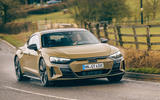Here’s a test of character. Perhaps the first I can remember being like this. Can two battery-electric vehicles that share so many of their underpinnings feel like two different cars, from different brands, when both have a premium and performance slant? When both marques scream individuality?
This striking four-door saloon is the new RS E-tron GT, faster of two new Audi E-tron GT derivatives. Here, RS means RS like RS6 or RS7 – it’s the really fast version.
The E-tron is a big five-seater, which at 4.99m long is the same length as an Audi A6 but it’s wider and much lower. Which, to my eyes, makes it look rather spectacular, though when one is pinned three inches from your boot you may think differently.
The underpinnings are the telling thing, though, and they’re the Volkswagen Group’s J1 platform, which is also beneath the Porsche Taycan. As in, they’re really, really the same as the Porsche Taycan, down to wheelbase, battery size, motor positions and some outputs. There’s much more shared than most internally combusted cars from different brands on the same platform.
As with the Porsche, then, there’s a 93.4kWh total capacity battery with a 83.7kWh usable section, creating a 283-mile WLTP range. One motor at the rear, another at the front, four-wheel drive and a two-speed gearbox for the rear only, which is rarely used (launch control and the most dynamic modes only).














































